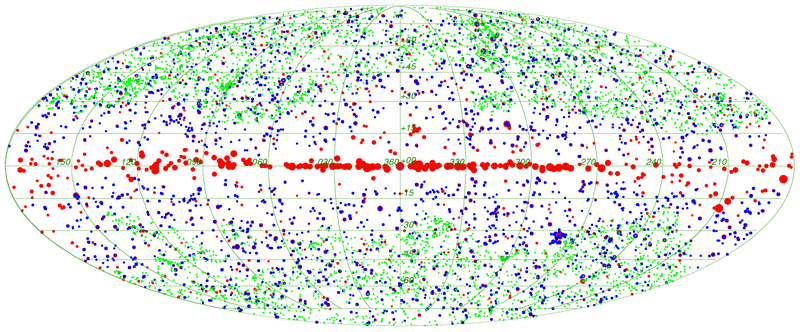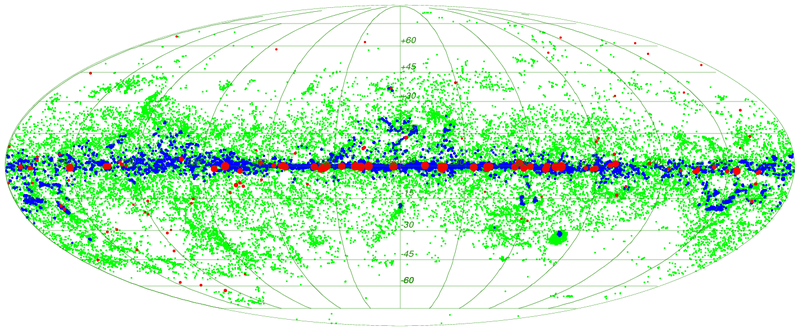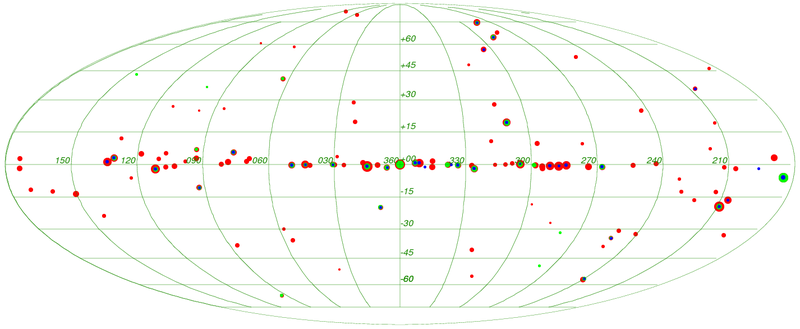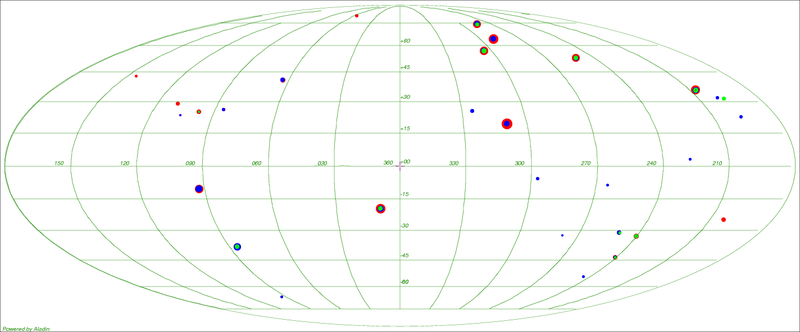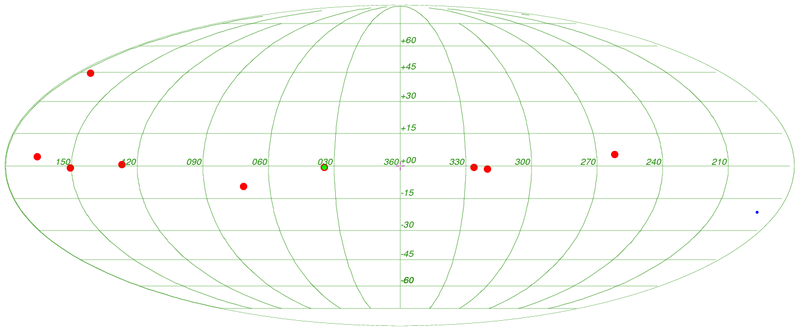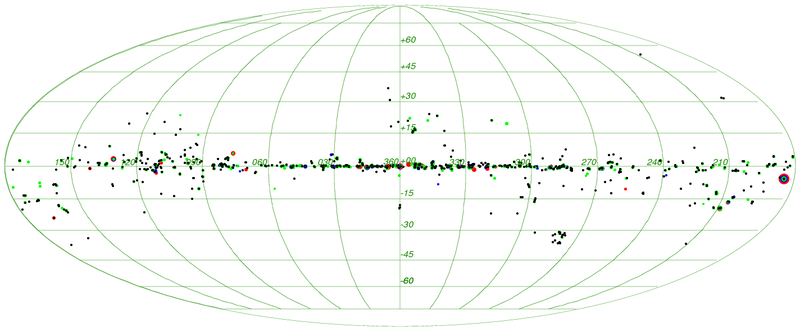Catalogues
Contents
Catalogue of Compact Sources[edit]
Product description[edit]
The second version of the Planck Catalogue of Compact Sources (PCCS2 and PCCS2E) is a set of single-frequency lists of sources extracted from the Planck full-mission maps in intensity and polarization.
The main difference between the PCCS2 and PCCS2E is that the sources in the PCCS2 have been validated, either statistically or by using external catalogues, while the PCCS2E contains the remaining sources for which it has not been possible to estimate their reliability. By definition, the reliability of the PCCS2 is > 80%, and a flag is available that allows the user to select a subsample of sources with a higher level of reliability (e.g., 90% or 95%).
Four different photometry methods have been used. For one of the methods, the native photometry from the Mexican hat wavelet detection algorithm, the analysis is performed on patches containing tangent plane projections of the map. For the other methods (aperture photometry, point spread function fitting, and Gaussian fitting), the analysis is performed directly on the full-sky maps.
The deeper completeness levels and, as a consequence, the higher number of sources compared with its predecessors the PCCS and the ERCSC, allows the extension of previous studies to more sources and to fainter flux densities.
The analysis in polarization has been performed in a non-blind fashion, looking at the position of the sources previously detected in intensity. As a result, polarization flux densities and polarization angles have been measured for hundreds of sources with a significance >99.99%. This high threshold in significance has been chosen to minimize the possibility of misinterpreting a peak of the polarized background as a source. This implies that, in general, most of the polarized sources are very bright, introducing an additional selection effect.
| Channel | 30 | 44 | 70 | 100 | 143 | 217 | 353 | 545 | 857 |
|---|---|---|---|---|---|---|---|---|---|
| Frequency [GHz] | 28.4 | 44.1 | 70.4 | 100.0 | 143.0 | 217.0 | 353.0 | 545.0 | 857.0 |
| Wavelength [μm] | 10561 | 6807 | 4260 | 3000 | 2098 | 1382 | 850 | 550 | 350 |
| Number of sources | |||||||||
| PCCS2 | 1435 | 830 | 1101 | 1742 | 2160 | 2135 | 1344 | 1694 | 4891 |
| PCCS2E | 125 | 104 | 195 | 2487 | 4139 | 16842 | 22665 | 31068 | 43290 |
| Union PCCS2+PCCS2E | 1560 | 934 | 1296 | 4229 | 6299 | 18977 | 24009 | 32762 | 48181 |
| Number of sources in the extragalactic zonea. | |||||||||
| PCCS2 | 723 | 346 | 441 | 1742 | 2160 | 2135 | 1344 | 1694 | 4891 |
| PCCS2E | 22 | 21 | 63 | 0 | 0 | 26 | 289 | 839 | 2097 |
| Union PCCS2+PCSS2E | 745 | 367 | 504 | 1742 | 2160 | 2161 | 1633 | 2533 | 6988 |
| Flux densities [mJy] in the extragalactic zonea . | |||||||||
| PCCS2 | |||||||||
| minimumb | 378 | 621 | 456 | 232 | 147 | 127 | 242 | 535 | 720 |
| 90% completeness | 427 | 692 | 501 | 269 | 177 | 152 | 304 | 555 | 791 |
| uncertainty | 78 | 127 | 92 | 55 | 35 | 29 | 55 | 105 | 168 |
| PCCS2E | |||||||||
| minimumb | 356 | 494 | 398 | — | — | 189 | 350 | 597 | 939 |
| 90% completeness | 468 | 708 | 501 | — | — | 144 | 311 | 557 | 927 |
| uncertainty | 86 | 134 | 95 | — | — | 35 | 73 | 144 | 278 |
Table 1 Notes
a 30-70 GHz: the extragalactic zone is given by |b| > 30°. 100-857 GHz: outside of galactic region where the reliability cannot be accurately assessed. Note that for the PCCS2E the only sources which occur in this region lie in the filament mask.
b Minimum flux density of the catalogue in the extragalactic zone after excluding the faintest 10% of sources.
| Channel | 30 | 44 | 70 | 100 | 143 | 217 | 353 |
|---|---|---|---|---|---|---|---|
| Number of significantly polarized sources in PCCS2 | 113 | 29 | 33 | 20 | 25 | 11 | 1 |
| Minimum polarized flux densitya [mJy] | 117 | 181 | 284 | 138 | 148 | 166 | 453 |
| Polarized flux density uncertainty [mJy] | 46 | 88 | 91 | 30 | 26 | 30 | 81 |
| Minimum polarized flux density completeness 90% [mJy] | 199 | 412 | 397 | 135 | 100 | 136 | 347 |
| Minimum polarized flux density completeness 95% [mJy] | 251 | 468 | 454 | 160 | 111 | 153 | 399 |
| Minimum polarized flux density completeness 100% [mJy] | 600 | 700 | 700 | 250 | 147 | 257 | 426 |
| Number of significantly polarized sources in PCCS2E | 9 | 1 | 1 | 43 | 111 | 325 | 666 |
| Minimum polarized flux densitya [mJy] | 101 | 2922 | 398 | 121 | 87 | 114 | 348 |
| Polarized flux density uncertainty [mJy] | 44 | 254 | 116 | 52 | 44 | 55 | 178 |
| Minimum polarized flux density completeness 90% [mJy] | — | — | — | 410 | 613 | 270 | 567 |
| Minimum polarized flux density completeness 95% [mJy] | — | — | — | 599 | 893 | 464 | 590 |
| Minimum polarized flux density completeness 100% [mJy] | — | — | — | 835 | 893 | 786 | 958 |
Table 2 Notes
a Minimum polarized flux density of the catalogue of significantly polarised sources after excluding the faintest 10% of sources.
Before using the PCCS2, please read the cautionary notes in the paper [1].
Production process[edit]
For a description of the production and validation process of the PCCS2 see the corresponding section.
Inputs[edit]
The nine Planck frequency channel maps are used as input to the source detection pipelines. They contain 48 months of data for LFI channels and 29 months of data for HFI channels. This implies that the flux densities of sources obtained from the full-mission maps are the average of at least 8 observations for LFI channels or at least 5 observations for HFI channels. The relevant properties of the frequency maps and main parameters used to generate the catalogues are summarized in Tables 1 and 2.
The input data used to generate this product are the following:
Catalogues[edit]
The PCCS2 catalogues are contained in the FITS files:
- COM_PCCS_030_R2.30.fits
- COM_PCCS_044_R2.30.fits
- COM_PCCS_070_R2.30.fits
- COM_PCCS_100_R2.20.fits
- COM_PCCS_143_R2.20.fits
- COM_PCCS_217_R2.20.fits
- COM_PCCS_353_R2.20.fits
- COM_PCCS_545_R2.20.fits
- COM_PCCS_857_R2.20.fits
and the PCCS2E catalogues are contained in the FITS files:
- COM_PCCSE_030_R2.30.fits
- COM_PCCSE_044_R2.30.fits
- COM_PCCSE_070_R2.30.fits
- COM_PCCSE_100_R2.20.fits
- COM_PCCSE_143_R2.20.fits
- COM_PCCSE_217_R2.20.fits
- COM_PCCSE_353_R2.20.fits
- COM_PCCSE_545_R2.20.fits
- COM_PCCSE_857_R2.20.fits
The structure of these files is as follows:
| Extension 0: Primary header, no data | |||
|---|---|---|---|
| FITS Keyword | Data Type | Units | Description |
| INSTRUME | String | Instrument (LFI / HFI) | |
| VERSION | String | Version of PCCS (PCCS2 / PCCS2_E) | |
| DATE | String | Date file created: yyyy-mm-dd | |
| ORIGIN | String | Name of organization responsible for the data (LFI-DPC / HFI-DPC) | |
| TELESCOP | String | PLANCK | |
| CREATOR | String | Pipeline Version | |
| DATE-OBS | String | days | Beginning of the survey: yyyy-mm-dd |
| DATE-END | String | days | End of the survey: yyyy-mm-dd |
| FWHM | Real*4 | arcmin | FWHM from an elliptical Gaussian fit to the beam |
| OMEGA_B | Real*4 | arcmin2 | Area of the main beam |
| FWHM_EFF | Real*4 | arcmin | FWHM computed from OMEGA_B assuming beam is Gaussian |
| OMEGA_B1 | Real*4 | arcmin2 | Beam area within a radius of 1 × FWHM_EFF |
| OMEGA_B2 | Real*4 | arcmin2 | Beam area within a radius of 2 × FWHM_EFF |
| Extension 1: (BINTABLE) | |||
| Column Name | Data Type | Units | Description |
| Identification | |||
| NAME | String | Source name (Note 1) | |
| Source Position | |||
| GLON | Real*8 | degrees | Galactic longitude based on extraction algorithm |
| GLAT | Real*8 | degrees | Galactic latitude based on extraction algorithm |
| RA | Real*8 | degrees | Right ascension (J2000) transformed from (GLON,GLAT) |
| DEC | Real*8 | degrees | Declination (J2000) transformed from (GLON,GLAT) |
| Photometry | |||
| DETFLUX | Real*4 | mJy | Flux density of source as determined by detection method |
| DETFLUX_ERR | Real*4 | mJy | Uncertainty (1 sigma) in derived flux density from detection method |
| APERFLUX | Real*4 | mJy | Flux density of source as determined from the aperture photometry |
| APERFLUX_ERR | Real*4 | mJy | Uncertainty (1 sigma) in derived flux density from the aperture photometry |
| PSFFLUX | Real*4 | mJy | Flux density of source as determined from PSF fitting |
| PSFFLUX_ERR | Real*4 | mJy | Uncertainty (1 sigma) in derived flux density from PSF fitting |
| GAUFLUX | Real*4 | mJy | Flux density of source as determined from 2-D Gaussian fitting |
| GAUFLUX_ERR | Real*4 | mJy | Uncertainty (1 sigma) in derived flux density from 2-D Gaussian fitting |
| GAU_SEMI1 | Real*4 | arcmin | Gaussian fit along axis 1 (FWHM; see Note 4 for axis definition) |
| GAU_SEMI1_ERR | Real*4 | arcmin | Uncertainty (1 sigma) in derived Gaussian fit along axis 1 |
| GAU_SEMI2 | Real*4 | arcmin | Gaussian fit along axis 2 (FWHM) |
| GAU_SEMI2_ERR | Real*4 | arcmin | Uncertainty (1 sigma) in derived Gaussian fit along axis 2 |
| GAU_THETA | Real*4 | deg | Gaussian fit orientation angle (Note 4) |
| GAU_THETA_ERR | Real*4 | deg | Uncertainty (1 sigma) in derived gaussian fit orientation angle |
| GAU_FWHM_EFF | Real*4 | arcmin | Gaussian fit effective FWHM |
| Polarization Measurements (30-353 GHz only) | |||
| P | Real*4 | mJy | Polarization flux density of the sources as determined by a matched filter (Note 4) |
| P_ERR | Real*4 | mJy | Uncertainty (1 sigma) in derived polarization flux density (Note 4) |
| ANGLE_P | Real*4 | degrees | Orientation of polarization with respect to NGP (Notes 4 and 5) |
| ANGLE_P_ERR | Real*4 | degrees | Uncertainty (1 sigma) in orientation of polarization (Note 4) |
| APER_P | Real*4 | mJy | Polarization flux density of the sources as determined by aperture photometry (Note 4) |
| APER_P_ERR | Real*4 | mJy | Uncertainty (1 sigma) in derived polarization flux density (Note 4) |
| APER_ANGLE_P | Real*4 | degrees | Orientation of polarization with respect to NGP (Notes 4 and 5) |
| APER_ANGLE_P_ERR | Real*4 | degrees | Uncertainty (1 sigma) in orientation of polarization (Note 4) |
| P_UPPER_LIMIT | Real*4 | mJy | Polarization flux density 99.99% upper limit. This is provided only when P column is set to NULL; otherwise this column itself contains a NULL. |
| APER_P_UPPER_LIMIT | Real*4 | mJy | Polarization flux density 99.99% upper limit. This is provided only when APER_P column is set to NULL; otherwise this column itself contains a NULL. |
| Marginal Polarization Measurements (100-353 GHz only) | |||
| P_STAT | Integer*2 | Polarization detection status (Note 6) | |
| PX | Real*4 | mJy | Polarization flux density of the sources as determined by a matched filter; Bayesian polarization estimator (Note 6) |
| PX_ERR_LOWER | Real*4 | mJy | PX uncertainty; lower 95% error bar (Note 6) |
| PX_ERR_UPPER | Real*4 | mJy | PX uncertainty; upper 95% error bar (Note 6) |
| ANGLE_PX | Real*4 | degrees | Orientation of polarization with respect to NGP; Bayesian polarization estimator (Notes 5 and 6) |
| ANGLE_PX_ERR_LOWER | Real*4 | degrees | ANGLE_PX uncertainty; lower 95% error bar (Note 6) |
| ANGLE_PX_ERR_UPPER | Real*4 | degrees | ANGLE_PX uncertainty; upper 95% error bar (Note 6) |
| Flags and validation | |||
| EXTENDED | Integer*2 | Extended source flag (Note 2) | |
| EXT_VAL | Integer*2 | External validation flag (Note 3) | |
| ERCSC | String | Name of the ERCSC counterpart, if any | |
| PCCS | String | Name of the PCCS counterpart, if any | |
| HIGHEST_RELIABILITY_CAT | Integer*4 | See Note 8 | |
| Flags and validation (100-857 GHz only) | |||
| WHICH_ZONE | Integer*2 | See Note 7 | |
| Flags and validation (217-857 GHz only) | |||
| CIRRUS_N | Integer*2 | Number of sources (S/N > 5) detected at 857 GHz within a 1-degree radius. | |
| SKY_BRIGHTNESS | Real*4 | MJy/sr | The mean 857 GHz brightness within a 2-degree radius. This may be used as another indicator of cirrus contamination. |
| Flux densities at other frequencies (857 GHz only) | |||
| APERFLUX_217 | Real*4 | mJy | Estimated flux density at 217 GHz |
| APERFLUX_ERR_217 | Real*4 | mJy | Uncertainty in flux density at 217 GHz |
| APERFLUX_353 | Real*4 | mJy | Estimated flux density at 353 GHz |
| APERFLUX_ERR_353 | Real*4 | mJy | Uncertainty in flux density at 353 GHz |
| APERFLUX_545 | Real*4 | mJy | Estimated flux density at 545 GHz |
| APERFLUX_ERR_545 | Real*4 | mJy | Uncertainty in flux density at 545 GHz |
Notes
- Source names consist of a prefix and a position. The prefix used is PCCS2 fff for the catalogue at fff GHz. The position is in Galactic coordinates and specified as "Glll.ll±bb.bb" where the (l,b) values are truncated to two decimal places. For example, a source detected at (l,b) = (120.237, 4.231) in the 545 GHz map would be labelled PCCS2 545 G120.23+04.23.
- The EXTENDED flag has the value of 0 if the source is compact and the value of 1 is it extended. The source size is determined by the geometric mean of the Gaussian fit FWHMs, with the criteria for extension being sqrt(GAU_FWHMMAJ * GAU_FWHMIN) > 1.5 times the beam FWHM.
- The EXT_VAL flag takes the value of 0, 1, 2, or 3 based on the following conditions:
- 3 – The source has a clear counterpart in one of the catalogues considered as ancillary data.
- 2 – The source does NOT have a clear counterpart in one of the catalogues considered as ancillary data but it has been detected by the internal multi-frequency method.
- 1 – The source does NOT have a clear counterpart in one of the catalogues considered as ancillary data and it has NOT been detected by the internal multi-frequency method, but it has been detected in a previous Planck source catalogue.
- 0 – The source does NOT have a clear counterpart in one of the catalogues considered as ancillary data and it has NOT been detected by the internal multi-frequency method.
- Provided when the significance of the polarization measurement is > 99.99% and set to NULL otherwise.
- We follow the IAU/IEEE convention (Hamaker & Bregman 1996) for defining the angle of polarization of a source. The polarization angle is measured from the North Galactic Pole in a clockwise direction from -90 to 90 degrees.
- The PX fields are only available for the 100-353 GHz channels. All PX fields contain NULL each time a bright detection is found and the P field contains a value different from 0.
- Polarization detection status (P_STAT):
- 3 – Bright. P field filled in; All PX fields set to NULL.
- 2 – Significant. P field set to NULL; 0 is outside of the PX 95% HPD; All PX fields are filled.
- 1 – Marginal. P field set to NULL; 0 is inside of the PX 95% HPD, but mode of PX posterior distribution is different from 0; All PX fields are filled.
- 0 – No detection. P field set to NULL; mode of PX posterior distribution is 0; PX_ERRL, ANGLE_PX, ANGLE_PX_ERR_LOWER, ANGLE_PX_ERR_UPPER set to NULL.
- The WHICH_ZONE column encodes the zone in which the source lies. (1 – source lies inside filament mask, 2 – source lies inside galactic zone, 3 – sources lies in both filament mask and galactic zone). NOTE: this column is only present when the version keyword in the primary header is set to PCCS2_E.
- The HIGHEST_RELIABILTY_CAT column contains the highest reliability catalogue to which the source belongs. As the full catalogue reliability is 80%, this is the lowest possible value in this column. Where possible this is provided in steps of 1% otherwise it is in steps of 5%. NOTE: this column is only present when the version keyword in the primary header is set to PCCS2.
Zone map[edit]
For each frequency channel there is an associated map which defines the quantified-reliability and unquantified-reliability zones are on the sky.
The files are called:
The structure of the files is as follows:
| Extension 0: Primary header, no data | |||
|---|---|---|---|
| FITS Keyword | Data Type | Units | Description |
| NSIDE | Integer | Nside of HEALPix map | |
| ORDERING | String | Ordering of pixels | |
| FREQ_CHL | String | Frequency channel | |
The FITS extension contains an integer HEALPix map which encodes the information of the 4 possible regions on the sky (0 – quantified-reliability zone, 1 – filament mask, 2 – galactic zone, 3 – filament mask and galactic zone).
S/N threshold map[edit]
For each HFI frequency channel there is an associated map which contains the S/N threshold used to accept sources into the PCCS2 and PCCS2E catalogues.
The files are called:
The structure of the files is as follows:
| Extension 0: Primary header, no data | |||
|---|---|---|---|
| FITS Keyword | Data Type | Units | Description |
| NSIDE | Integer | Nside of HEALPix map | |
| ORDERING | String | Ordering of pixels | |
| FREQ_CHL | String | Frequency channel | |
The FITS extension contains a single precision HEALPix map of the S/N threshold applied in the generation of the catalogue at that position on the sky.
Noise map[edit]
For each HFI frequency channel there is an associated map which contains the detection noise as a function of position on the sky.
The files are called:
The structure of the files is as follows:
| Extension 0: Primary header, no data | |||
|---|---|---|---|
| FITS Keyword | Data Type | Units | Description |
| NSIDE | Integer | Nside of HEALPix map | |
| ORDERING | String | Ordering of pixels | |
| FREQ_CHL | String | Frequency channel | |
The FITS extension contains a single precision HEALPix map of the detection noise at each location on the sky.
SZ Catalogue[edit]
The Planck SZ catalogue is constructed as described in SZ catalogue and in section 2 of [2]. Three pipelines are used to detect SZ clusters: two independent implementations of the Matched Multi-Filter (MMF1 and MMF3), and PowellSnakes (PwS). The main catalogue is constructed as the union of the catalogues from the three detection methods. The completeness and reliability of the catalogues have been assessed through internal and external validation as described in sections 3-6 of [2].
The size of a detection is given in terms of the scale size, θs, and the flux is given in terms of the total integrated Comptonization parameter, Y = Y5R500. The parameters of the GNFW profile assumed by the detection pipelines are written in the headers of the catalogues. For the sake of convenience, the conversion factor from Y to Y500 is also provided in the header.
The union catalogue contains the coordinates of a detection, its signal-to-noise ratio, an estimate of Y and its uncertainty, together with a summary of the validation information, including external identification of a cluster and its redshift if they are available. The pipeline from which the information is taken is called the reference pipeline. If more than one pipeline makes the same detection, the information is taken from the the pipeline that makes the most significant detection. Where the redshift is known, we provide the SZ mass for the reference pipeline.
The individual catalogues contain the coordinates and the signal-to-noise ratio of the detections, and information on the size and flux of the detections. The entries are cross-referenced to the detections in the union catalogue. The full information on the degeneracy between θs and Y is included in the individual catalogues in the form of the two-dimensional probability distribution for each detection. It is computed on a well-sampled grid to produce a two-dimensional image for each detection. It is provided in this form so it can be combined with a model or external data to produce tighter constraints on the parameters. The individual catalogues also contain Planck measurements of the SZ mass observable, MSZ, as calculated using a Y-M scaling relation and an assumed redshift to break the Y-θs degeneracy. These are provided for each detection as functions of assumed redshift, in the range 0.01 < z < 1, along with the upper and lower 67% confidence limits.
The selection function of the union catalogue, the intersection catalogue and the individual catalogues are provided in additional files. The selection function files contains the probability of detection for clusters of given intrinsic parameters θ500 and Y500. The file includes the definition of the survey area in the form of a HEALPix mask, and is evaluated for a range of signal-to-noise thresholds between 4.5 and 10.
Union catalogue[edit]
The union catalogue is contained in HFI_PCCS_SZ-union_R2.07.fits.
| Extension 0: Primary header, no data | |||
|---|---|---|---|
| FITS Keyword | Data Type | Units | Description |
| INSTRUME | String | Instrument (HFI) | |
| VERSION | String | Version of catalogue | |
| DATE | String | Date file created: yyyy-mm-dd | |
| ORIGIN | String | Name of organization responsible for the data (HFI-DPC) | |
| TELESCOP | String | Telescope (PLANCK) | |
| CREATOR | String | Pipeline version | |
| DATE-OBS | String | Start date of the survey: yyyy-mm-dd | |
| DATE-END | String | End date of the survey: yyyy-mm-dd | |
| PROCVER | String | Data version | |
| PP_ALPHA | Real*4 | GNFW pressure profile α parameter | |
| PP_BETA | Real*4 | GNFW pressure profile β parameter | |
| PP_GAMMA | Real*4 | GNFW pressure profile γ parameter | |
| PP_C500 | Real*4 | GNFW pressure profile c500 parameter | |
| PP_Y2YFH | Real*4 | Conversion factor from Y to Y500 | |
| Extension 1: BINTABLE, EXTNAME = PSZ2_UNION | |||
| Column Name | Data Type | Units | Description |
| INDEX | Int*4 | Index used to cross-reference with individual catalogues | |
| NAME | String | Source name (see note 1) | |
| GLON | Real*8 | degrees | Galactic longitude |
| GLAT | Real*8 | degrees | Galactic latitude |
| RA | Real*8 | degrees | Right ascension (J2000) transformed from (GLON,GLAT) |
| DEC | Real*8 | degrees | Declination (J2000) transformed from (GLON,GLAT) |
| POS_ERR | Real*4 | arcmin | Position uncertainty (95% confidence interval) |
| SNR | Real*4 | Signal-to-noise ratio of the detection | |
| PIPELINE | Int*4 | Pipeline from which information is taken (reference pipeline): 1= MMF1; 2 = MMF3; 3 = PwS | |
| PIPE_DET | Int*4 | Pipelines which detect this object (see note 2) | |
| PCCS2 | Bool | Indicates whether detection matches with any in PCCS2 catalogues | |
| PSZ | Int*4 | Index of matching detection in PSZ1, or -1 if new detection | |
| IR_FLAG | Int*1 | Flag denoting heavy infrared contamination | |
| Q_NEURAL | Real*4 | Neural network quality flag (see note 3) | |
| Y5R500 | Real*4 | 10-3 arcmin2 | Mean marginal Y5R500 as determined by reference pipeline |
| Y5R500_ERR | Real*4 | 10-3 arcmin2 | Uncertainty on Y5R500 as determined by reference pipeline |
| VALIDATION | Int*4 | External validation status (see note 4) | |
| REDSHIFT_ID | String | External identifier of cluster associated with redshift measurement (see note 5) | |
| REDSHIFT | Real*4 | Redshift of cluster (see note 5) | |
| MSZ | Real*4 | 1014 Msol | SZ mass proxy (see note 6) |
| MSZ_ERR_UP | Real*4 | 1014 Msol | Upper bound of 68% SZ mass proxy confidence interval (see note 6) |
| MSZ_ERR_LOW | Real*4 | 1014 Msol | Lower bound of 68% SZ mass proxy confidence interval (see note 6) |
| MCXC | String | Identifier of X-ray counterpart in the MCXC, if one is present | |
| REDMAPPER | String | Identifier of optical counterpart in the RedMAPPer catalogue, if one is present | |
| ACT | String | Identifier of SZ counterpart in the ACT catalogues, if one is present | |
| SPT | String | Identifier of SZ counterpart in the SPT catalogues, if one is present | |
| WISE_FLAG | Int*4 | Confirmation flag of WISE overdensity (see note 7) | |
| AMI_EVIDENCE | Real*4 | Bayesian evidence for AMI counterpart detection (see note 8) | |
| COSMO | Bool | Indicates whether detection is in the cosmology sample | |
| COMMENT | String | Comments on this detection | |
Notes
- Format is PSZ2 Glll.ll±bb.b where (l,b) are the Galactic coordinates truncated to 2 decimal places.
- The three least significant decimal digits are used to represent detection or non-detection by the pipelines. Order of the digits: hundreds = MMF1; tens = MMF3; units = PwS. If it is detected then the corresponding digit is set to 1, otherwise it is set to 0.
- Neural network quality flag is 1-Qbad, following the definitions in Aghanim et al. 2014.
- Summary of the external validation, encoding the most robust external identification: 10 = ENO follow-up; 11 = RTT follow-up; 12 = PanSTARRs; 13 = RedMAPPer non-blind; 14 = SDSS high-z; 15 = AMI; 16 = WISE; 20 = legacy identification from the PSZ1; 21 = MCXC; 22 = SPT; 23 = ACT; 24 = RedMAPPer; 30 = NED; -1 = no known external counterpart.
- Redshift source is the most robust external identification listed in the VALIDATION field.
- MSZ is the hydrostatic mass assuming the best-fit Y-M scaling relation of Arnaud 2010 as a prior. The uncertainties are statistical and based on the Planck measurement uncertainties only. Not included in the uncertainties are the statistical errors on the scaling relation, the intrinsic scatter in the relation, or systematic errors in data selection for the scaling relation fit.
- Assigned by visual inspection: 0 = no significant galaxy overdensity; 1 = possible galaxy overdensity; 2 = probable galaxy overdensity; 3 = significant galaxy overdensity detected; -1 = possible galaxy overdensity (affected by bright star artefacts); -2 = no significant galaxy overdensity (affected by bright star artefacts); -10 no assessment possible (affected by bright star artefacts).
- Defined in the paper.
Individual catalogues[edit]
The individual pipeline catalogues are contained in the FITS files
- HFI_PCCS_SZ-MMF1_R2.07.fits (Matched Multi-Filter method #1)
- HFI_PCCS_SZ-MMF3_R2.07.fits (Matched Multi-Filter method #3)
- HFI_PCCS_SZ-PwS_R2.07.fits (Powell Snakes method)
Their structure is as follows:
| Extension 0: Primary header, no data | |||
|---|---|---|---|
| FITS Keyword | Data Type | Units | Description |
| INSTRUME | String | Instrument (HFI) | |
| VERSION | String | Version of catalogue | |
| DATE | String | Date file created: yyyy-mm-dd | |
| ORIGIN | String | Name of organization responsible for the data (HFI-DPC) | |
| TELESCOP | String | Telescope (PLANCK) | |
| CREATOR | String | Pipeline version | |
| DATE-OBS | String | Start time of the survey: yyyy-mm-dd | |
| DATE-END | String | End time of the survey: yyyy-mm-dd | |
| PROCVER | String | Data version | |
| PP_ALPHA | Real*4 | GNFW pressure profile α parameter | |
| PP_BETA | Real*4 | GNFW pressure profile β parameter | |
| PP_GAMMA | Real*4 | GNFW pressure profile γ parameter | |
| PP_C500 | Real*4 | GNFW pressure profile c500 parameter | |
| PP_Y2YFH | Real*4 | Conversion factor from Y to Y500 | |
| Extension 1: EXTNAME = PSZ2_INDIVIDUAL (BINTABLE) | |||
| Column Name | Data Type | Units | Description |
| INDEX | Int*4 | Index from union catalogue | |
| NAME | String | Source name (see note 1) | |
| GLON | Real*8 | degrees | Galactic longitude |
| GLAT | Real*8 | degrees | Galactic latitude |
| RA | Real*8 | degrees | Right ascension (J2000) transformed from (GLON, GLAT) |
| DEC | Real*8 | degrees | Declination (J2000) transformed from (GLON, GLAT) |
| POS_ERR | Real*4 | arcmin | Position uncertainty (95% confidence interval) |
| SNR | Real*4 | Signal-to-noise ratio of detection | |
| TS_MIN | Real*4 | Minimum value of θs in grid in second extension HDU (see note 2) | |
| TS_MAX | Real*4 | Maximum value of θs in grid in second extension HDU (see note 2) | |
| Y_MIN | Real*4 | Minimum value of Y in grid in second extension HDU (see note 2) | |
| Y_MAX | Real*4 | Maximum value of Y in grid in second extension HDU (see note 2) | |
| Keyword | Data Type | Value | Description |
| PIPELINE | String | Name of detection pipeline | |
| Extension 2: EXTNAME = PSZ2_PROBABILITY (IMAGE) – see note 2 | |||
| Keyword | Data Type | Value | Description |
| NAXIS1 | Integer | 256 | Dimension 1 |
| NAXIS2 | Integer | 256 | Dimension 2 |
| NAXIS3 | Integer | Ndet | Dimension 3 = Number of detections |
| Keyword | Data Type | Value | Description |
| PIPELINE | String | Name of detection pipeline | |
| Extension 3: EXTNAME = PSZ2_MSZ_ARRAY (IMAGE) – see note 3 | |||
| Keyword | Data Type | Value | Description |
| NAXIS1 | Integer | 100 | Dimension 1 |
| NAXIS2 | Integer | 4 | Dimension 2 |
| NAXIS3 | Integer | Ndet | Dimension 3 = Number of detections |
| Keyword | Data Type | Value | Description |
| PIPELINE | String | Name of detection pipeline | |
Notes
- Format PSZ1 Glll.ll±bb.bb where (l, b) are the Galactic coordinates truncated to 2 decimal places.
- Extension 2 contains a three-dimensional image with the two-dimensional probability distribution in θs and Y for each detection. The probability distributions are evaluated on a 256 × 256 linear grid between the limits specified in extension 1. The limits are determined independently for each detection. The dimension of the 3D image is 256 × 256 × Ndet, where Ndet is the number of detections. The first dimension is θs and the second dimension is Y.
- Extension 3 contains a three-dimensional image with the information on the MSZ observable per cluster as a function of assumed redshift. The image dimensions are 100 × 4 × Ndet, where Ndet is the number of detections. The first dimension is the assumed redshift. The second dimension has size 4: the first element is the assumed redshift value corresponding to the MSZ values. The second element is the MSZ lower 68% confidence bound, the third element is the MSZ estimate and the fourth element is the MSZ upper 68% confidence bound, all in units of 1014 Msol. These uncertainties are based on the Planck measurement uncertainties only. Not included in the error estimates are the statistical errors on the scaling relation, the intrinsic scatter in the relation, or systematic errors in data selection for the scaling relation fit.
Selection function[edit]
Galactic Cold Core Catalogue[edit]
TBW - Montier
Catalogue of High-Redshift Sources[edit]
TBW - Montier
References[edit]
Early Release Compact Source Catalog
(Planck) Low Frequency Instrument
(Planck) High Frequency Instrument
Flexible Image Transfer Specification
Data Processing Center
Full-Width-at-Half-Maximum
(Hierarchical Equal Area isoLatitude Pixelation of a sphere, <ref name="Template:Gorski2005">HEALPix: A Framework for High-Resolution Discretization and Fast Analysis of Data Distributed on the Sphere, K. M. Górski, E. Hivon, A. J. Banday, B. D. Wandelt, F. K. Hansen, M. Reinecke, M. Bartelmann, ApJ, 622, 759-771, (2005).
Sunyaev-Zel'dovich
